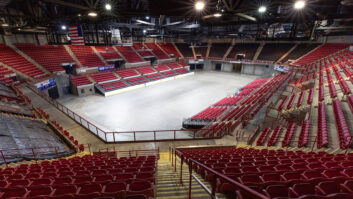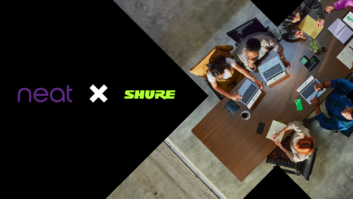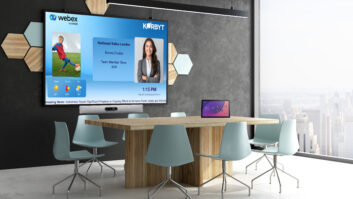Lake Technology Lake Contour
Sep 1, 2003 12:00 PM,
Bob Hodas
The most basic description of Lake Technology’s Lake Contour is that it’s a crossover, a delay, a dynamics processor, an equalizer, and a DSP-based speaker controller. Yet the Contour’s hardware and software really set it apart from other processors. Its use of new filter concepts, high-quality components, an exceptionally clean signal path, simple graphic computer interface, and wireless control put it into a class by itself. The Contour was conceptualized for the live sound market, but its high quality will find a welcome home in permanent installations as well as the studio monitor market.
Since the Contour began its life in 1997 as the Clair Brothers’ Clair iO, Lake Technologies had the advantage of road testing and working out the bugs long before the Contour came to market for the general public. It also means that refinements could be implemented, as well.
The unit is a 2-in, 6-out box that may be set up as two, three-way crossovers or even as a four-way crossover. All internal processing is performed at 40-bit precision, and conversion is through 24-bit/96 kHz converters. Multiple boxes may be linked together through standard Ethernet cables for total system control from one computer.
All parameters are stored in nonvolatile memory, so if the Contour loses power during operation, it returns to its exact state prior to the loss of power. If a network communication problem occurs, the sound output from the Contour processors continues without interruption.
HARDWARE
The back panel contains the balanced ins and outs, a 3-pin IEC power socket (internal autoranging power supply), and a three-position ground switch. At the 2003 AES, Lake will introduce a version with a digital input. So those of you with digital desks will be able to get into the Contour with no conversion. The Lake Contour Iso-Float technology incorporates the benefits of transformer-coupled ground isolation while maintaining the advantages of clean, direct-coupled inputs and outputs. The audio converters are galvanically isolated and not connected to the main ground. That technique uses high-speed transformers and optoisolators to create a barrier between the device and any grounding aberrations from the outside electrical environment. The RS-232 and two RJ-45 data ports are for PC communications to the Contour and to link multiple units.
The front panel is fairly simple, because the PC controller does most of the work. There is the on/off switch and a select switch that identifies the unit on the network. Four alphanumeric windows let you quickly identify individual units in the system as well as scroll status information. There are two 10-Base2 coax connectors — a 10 MHz Ethernet system running over thin, 50ž baseband, coaxial cable — for linking units together just as can be done on the back panel. A front-panel RJ-45 jack lets you plug a computer right in. I like the idea of having the access and linking abilities accessible from either the front or back. Eight mute switches sit beneath segmented LED level meters for the inputs and outputs, which indicate mute, level, and clipping. Three LEDs signal power, Ethernet communication, and external control.
COMPUTER CONTROL
The control program will run on a wide variety of Windows systems (98, ME, 2000, and XP). I have ME on my computer, and it usually barfs on custom software, but not this time. Lake Technology recommends at least a 600 MHz Pentium III, but the fastest box you can get will make you feel the power and speed of the WiFi controller interface with speeds of up to 10 Mbps. You would also do well to use a touch-screen tablet in order to work with optimum ease and speed. A touch-screen tablet is lightweight and can be held in one hand while tapping out commands with a pen-style pointer. Hauling it around a venue, especially during a show, will be a breeze.
Sound system information is presented in color on touch-screen displays. The wireless remote has intuitive, easy-to-understand controls, allowing an engineer to set up the system from any seat in the house, move about the venue, listen, and adjust any parameter of any Contour on the Ethernet network. Adjustments can be made to any parameter of any Contour on the network and to selected groups of processors.
A speaker can be a member of more than one group. Adjustments can be made virtually in real time giving the responsiveness of an analog unit. After extensive testing of available wireless networking solutions, Lake feels that performance varies significantly among 802.11b wireless vendors, so the company provides its own wireless networking package for the Contour system, which eliminates guesswork.
Of course, there are many options of creating preferences, storing, saving, and recalling system configurations. For instance, the three files types are:
- the base module file, which stores the module’s signal-processing path and functions;
- the single module file, which stores all information contained within the base module file as well as specific settings for each module that include the mute states, levels (gain, delay, and limiters), equalization (filters and EQ overlays), and group membership information;
- and the system configuration file, which stores and recalls all information contained within the single module file for each module on a given network.
Lake’s graphical user interface has made these processes straightforward.
For permanent installations, when setup procedures need to be kept separate and safe by the installer, two operating modes are provided. In the password-protected Designer mode, the sound designer adjusts all parameters and then limits access to system functions. In the User mode, the sound engineer uses a streamlined interface with setup parameters safely out of reach.
I know a fair number of live sound companies are using SIA Software’s SmaartLive to tune their sound systems. Lake is planning to use SmaartLive’s real-time analyzer, dual-channel impulse response (delay locator), and transfer function (frequency response) measurement capabilities. This will simply be a plug-in and not require any special software version. SmaartLive can run on the same computer as the Contour software, or you can run it on another computer over the network. You need only plug the SmaartLive computer in to the Contour network using a standard Ethernet connection, and SmaartLive will transmit the results of its number-crunching up to the Contour controller computer.
The advantage of this is that you can run SmaartLive at FOH and get signals from the console while sitting anywhere in the venue. An engineer could walk the venue with a wireless mic and the Contour tablet PC and listen and measure the system at the same time. Nice concept.
FILTERS
Because the Lake Contour synthesizes filters in real time, it is a perfect tool for live performance. A room setup could be implemented that had all of the delay, EQ, crossovers, and dynamics for the sound system. Then a personality curve could be layered on top of that, and additional filters could be imposed later during a show to keep the system in trim. There is almost no limit to the number of EQ curves that may be generated, though the uneducated could get into deep trouble with this kind of power. Lake is the first to introduce the concept of an EQ overlay that uses a tabbed user interface. Each overlay has a vast number of parametric or graphic equalization filters that contribute to the composite equalization curve.
The Contour controller has both parametric and 28-band graphic EQ filters simultaneously available to the user. EQ is situated both pre- and postcrossover. Significant improvements have been achieved in graphic and parametric filter design. EQ resolution is 1/24 octave — more sophisticated than any existing hardware-based system. Lake’s flat sum Ideal Graphic EQs do not interact like traditional equalizers. As the name implies, adjacent bands sum flat, something traditional ⅓-octave EQ cannot do. Lake is using raised cosine functions as opposed to traditionally implemented filters. That results in higher selectivity than traditional filters or, in other words, less bleeding into adjacent frequency bands.
Lake’s proprietary Mesa filter is a significant advance in EQ technology. It is intended to supersede the traditional parametric filter. Where other processors provide standard symmetrical boost and cut functions, the Mesa filter offers asymmetric filtering, with the ability to separate the sides of a parametric section, change center frequencies, and adjust slopes independently. That places a faster, more effective optimization tool in the sound engineer’s hands — one that can truly match the asymmetrical responses of loudspeakers. It certainly seems to be a more elegant way to approach a large venue system’s high-frequency rolloff. The ability to adjust the slopes independently also means that in order to get the desired curve, you will not generate out-of-band boosts, typical of traditional parametrics, which can result in speaker distortion and overexcursion. This is going to be a great creative tool for many users, giving engineers added levels of EQ sophistication.
CROSSOVERS
The Contour offers an extensive selection of linear phase, traditional, and nontraditional crossover filters. In addition to an extensive selection of traditional crossover filters, Lake introduces linear phase, brickwall crossovers, with transition slopes exceeding 100 dB per octave (266 dB per octave at 1 kHz). The benefits can be dramatic when applied to various types of loudspeaker arrays. Off-axis lobing and cancellation between drivers through crossover transition bands can be dramatically reduced. Linear phase response of the brickwall filters enables different speaker cabinet types to be easily mixed and matched, because there is significant improvement to the loudspeaker’s impulse response. Improvements of as much as 3 dB or more in acoustic output power may be expected in some frequency ranges because of the time-coherent wave front.
The Lake Contour offers true RMS and soft clamp limiting with threshold and corners adjustments on each output channel. By calculating the true RMS value of every sample, the system produces acoustically transparent results even under extreme limiting conditions. The soft clamp limiter removes the possibility of clipping by gently removing audio peaks, thus restricting the signal output’s swing that would otherwise drive an amplifier into distortion.
FADERS AND METERS
Other adjustable parameters not covered in the previous sections include A/D input headroom, input and output gain, and input and output delay. Those are all selectable on the levels screen. High-resolution, fast-updating meters simultaneously show true RMS and peak levels with peak hold. Several options are available for what point of the signal path the meters display and how that information is configured. There are fine and coarse modes for the faders, and most parameters can be adjusted within a hundredth of a decibel. For instance, a designer may want full control when setting up a system and then give the user a more restricted fader that would not allow drastic changes during a performance. I would like to see a different graphic for the delay control, which currently looks just like the level faders, because that can be confusing.
USE IT OR LOSE IT
The Contour is an excellent-sounding piece. It handles large and varied amounts of processing without any apparent sonic problems. The manual is well thought out and thorough, and it does a pretty good job teaching the complexities of the box. It has good graphics that help guide you through the instructions. This is a complex tool and certainly one that will add value and control to most sound systems. Be sure to give yourself some time to practice with the Contour in advance of your installation so that you can take full advantage of its power.
The Contour is deep but straightforward to use. Navigating around the controller is simplified because of the use of color-coded buttons. One Contour is considered a frame that has two modules representing inputs A and B. Adjustments to the system may be made either online or offline. Modules and frames may be labeled and give the user a variety of setting information at a glance. Most of the adjustments are simply activated through a tap or drag-and-drop methods.
Block diagrams make sure that you don’t lose your way through the complex signal path you design. Once I became used to the idea of the many layers, system setup went quickly. Accessing crossovers and EQ was fast and made simple with the extraordinary graphic interface. My one complaint is that it is too much fun to mess around with all of the parameters. I found myself doing more and more experimenting with crossovers and EQ. It’s a good thing there wasn’t a client staring over my shoulder.
Bob Hodasspends his days traveling around the world tuning studios and home theaters. Visit his site atwww.bobhodas.com.
SPECIFICATIONS
PERFORMANCE
A/D and D/A Conversion Resolution 24 bit
Internal Sampling Frequency 96 kHz
Internal Data Path 40-bit floating point
System Propagation Delay 2 ms, input to output
Maximum Available Delay 4 seconds (2 seconds per input, 2 seconds per output )
Iso-Float 3-Position Switch (1) I/O grounded to device (2) Inputs floating (3) I/O floating
DIGITAL-TO-ANALOG AUDIO OUTPUTS
Frequency Response +0/-0.1 dB, 3 Hz to 10 kHz +0/-0.5 dB, 2 Hz to 20 kHz
THD + Noise (Unweighted) 0.0005% typical @ 1 kHz, 0.0007% typical, 20 Hz to 20 kHz
Dynamic Range (Unweighted) 111 dB typical, 20 Hz to 20 kHz
Output Impedance 50ž
Maximum Output Level +21 dBu
ANALOG-TO-DIGITAL AUDIO INPUTS
Frequency Response +0/-0.1 dB, 2 Hz to 20 kHz
THD + Noise (Unweighted) 0.0005% typical @ 1 kHz 0.0006% typical, 20 Hz to 20 kHz
Dynamic Range (Unweighted) 113 dB typical, 20 Hz to 20 kHz
Input Impedance 20 kž balanced, 10 kž unbalanced
Maximum Input Level +24 dBu
Input Sensitivity Trim Range +12 dBu to +24 dBu, adjusted in 1 dB steps
COMBINED ANALOG-TO-DIGITAL AND DIGITAL-TO-ANALOG
THD + Noise (Unweighted) 0.0007% typical @ 1 kHz, 0.0009% typical, 20 Hz to 20 kHz
Dynamic Range (Unweighted) 109 dB typical, 20 Hz to 20 kHz
PHYSICAL
Chassis Size (H × W × D) 1.72 in (4.37 cm) × 19.00 in (48.26 cm) × 15.75 in (40.00 cm)
Net Weight 14 lb. (6.35 kg)
PRODUCT SUMMARY
Company: Lake Technology; www.contour.lake.com
Product: Lake Contour
Pros: Powerful processing tool. Good manual.
Cons: Could give novices trouble.
Applications: Loudspeaker processing in live venues.
Price: $4,999








